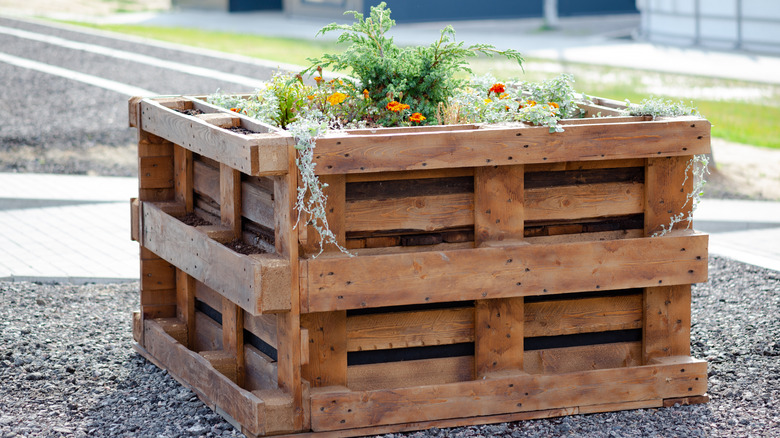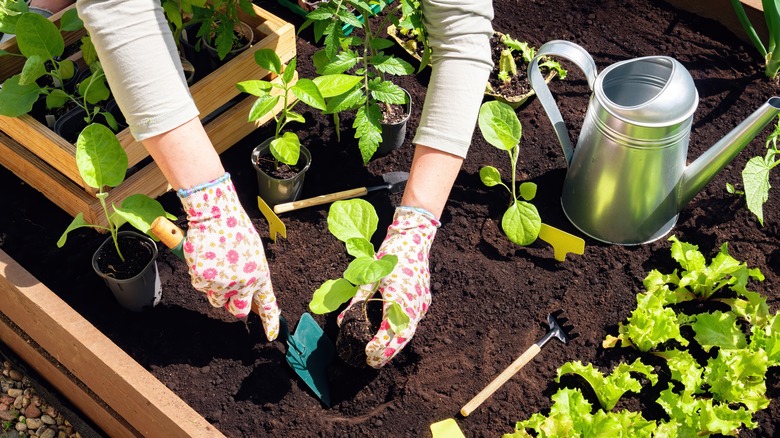Upcycle Wooden Pallets To Make The Ultimate Raised Garden Bed
Creating your own raised bed garden, lush with flowers and vegetables, can be quite the fulfilling hobby. It's also incredibly expensive and time-consuming. One unique way to cut down on the cost is to craft your raised bed by upcycling wooden pallets. Compared to purchasing new materials or pre-made raised beds, which could run a couple of hundred dollars, repurposing pallets is an affordable option. It allows individuals with limited resources or tight budgets to engage in gardening and enjoy the benefits of growing their own food.
Upcycling wooden pallets also promotes sustainability by repurposing discarded materials. Pallets are often tossed in the trash and end up in landfills, contributing to environmental degradation. By upcycling these pallets into raised garden beds, you can reduce waste and minimize the demand for new materials. At the same time, wooden pallets are usually made from untreated or minimally treated wood, which is great for gardening purposes. This makes them safe for growing vegetables, herbs, and other plants. Swing behind your local strip mall to investigate whether any stores have left pallets out for trash and inquire to see if they're willing to donate them to you for your next garden project.
How to assemble your raised garden from wooden pallets
Assembling raised garden beds from wooden pallet pieces requires some basic tools, but is manageable for beginners. Once you've collected minimally-treated wooden pallets in good condition, you'll also need a measuring tape, drill, screws or nails, and a hammer. Carefully inspect the pallets for any damage or protruding nails. Remove any loose nails or damaged pieces. To start, use the hammer to disassemble the pallets into individual boards. Set aside the boards to use for the sides of the garden bed.
Next, take two longer boards for the sides of the bed and attach them to the shorter ones using screws or nails. Square the corners with a carpenter's square or by measuring diagonally from corner to corner. To provide stability and durability, add additional pieces of wood or corner braces to reinforce the corners of the bed. Attach them securely with screws or nails. Remember to consider the height and accessibility of the raised bed. If desired, you can stack additional pallet boards to increase the height.
Finally, find a suitable location for your raised bed based on the sunlight needs of your anticipated plants. Level the ground if necessary and place the assembled bed in the desired position. Fill the bed with high-quality soil and compost for the plants you plan to grow. Typically, local nurseries or hardware stores will deliver soil and compost in bulk, making it a cheaper option than buying soil in bags.
Planting your new raised garden bed
Planting a raised garden bed involves several essential steps to ensure successful growth and healthy plants. Begin by preparing the soil in your raised bed. Ideally, use a mixture of gardening soil, compost, and organic matter. This combination provides the necessary nutrients plants require and promotes good drainage. Aim for a soil depth of at least 12 inches to allow for proper root development. For deeper beds, consider filling the bottom with mulch, cardboard, sticks, and fallen leaves to reduce the amount of soil and compost you'll need to purchase.
Raised beds offer great growing conditions, and a wide range of plants thrive in them. Consider the specific needs of the plants you want to grow, such as sunlight requirements, spacing, and water needs. Generally, vegetables like tomatoes, lettuce, carrots, peppers, and herbs perform well in raised beds. Flowers, such as marigolds or petunias, can also be added to attract beneficial pollinators. Typically, raised beds require more frequent watering than ground-level gardens since they tend to drain faster. Water the plants deeply, ensuring it reaches the roots. Mulching around the plants can help retain moisture. Monitor the moisture level regularly and adjust watering accordingly.
Finally, consider incorporating organic fertilizers or compost into the soil before planting. Additionally, you can use organic liquid fertilizers during the growing season to provide necessary nutrients, especially for heavy feeders like tomatoes. Follow the package instructions or consult a gardening guide for the specific needs of your plants.

